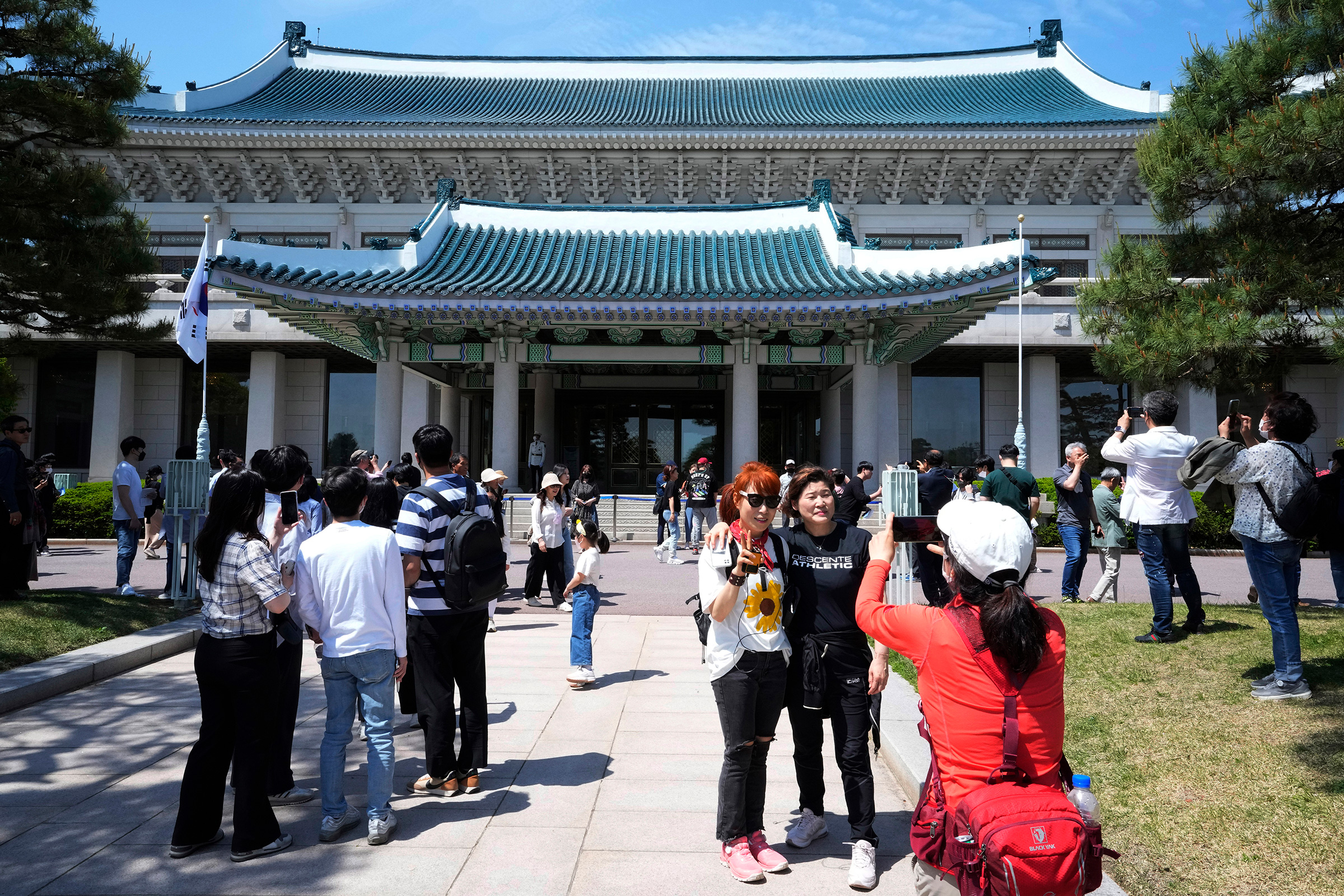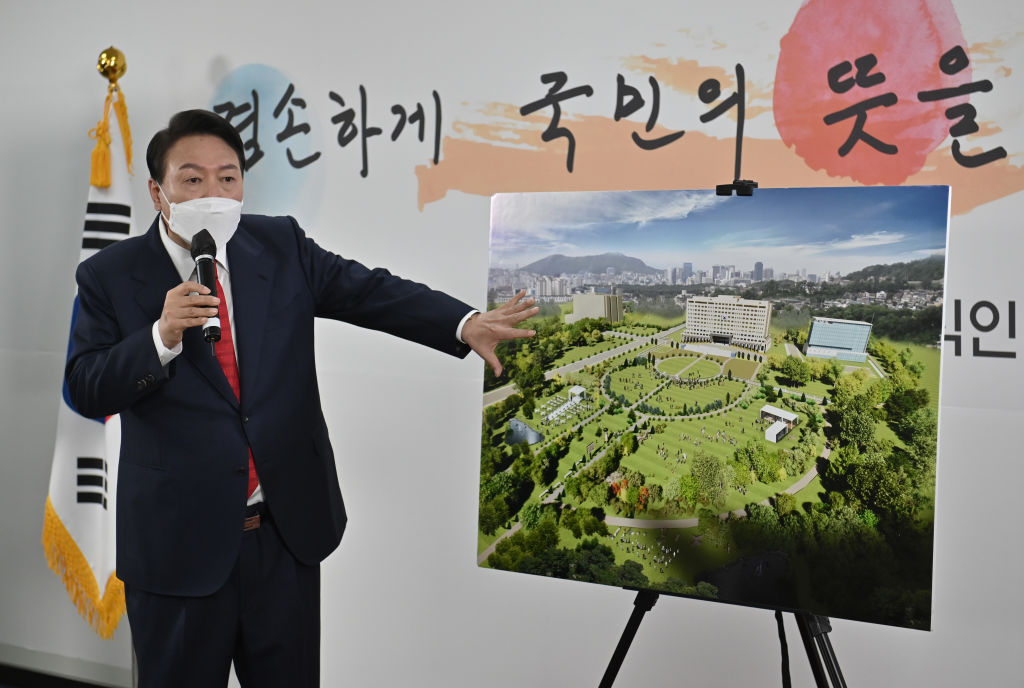
Veteran K-pop superstar Rain made South Korean history on June 17 when he staged a concert at Cheongwadae—the former presidential compound commonly known as the Blue House—which opened to the public on May 10.
It’s not the first concert in the Blue House’s 74-year history. National broadcaster KBS claimed that honor with its “KBS Open Concert” on May 22, as part of the Blue House’s opening festivities. But Rain’s gig—which will be taped by Netflix to use for Rain’s upcoming show—marks a tonal shift in how South Korea regards this bastion of power.
While past presidents have traditionally stayed in the compound, newly-elected Yoon Suk-yeol has chosen to relocate the presidential office to a defense ministry complex in Seoul’s Yongsan district, claiming that the Blue House is too secluded and thus “out of touch” with voters. Yoon says moving out of the verdant 62-acre site will help “return presidential power to the people.”
Read more: Find out why Yoon Suk-yeol is one of TIME’s 100 most influential people of 2022
Officials have since relaunched the Blue House as a “relaxing retreat” for the public, who can book admission tickets online. Inside, visitors will be able to enjoy cultural performances, tours, and even hiking trails that lead to Bugak Mountain, Cheongwadae’s scenic backdrop.
Yoon’s decision to move out has not been a popular one. A survey released in March showed that some 58% of South Koreans were against the relocation, with many critics saying the move had implications for national security and cost. Some also worry that the issue has taken precedence over more pressing matters, like increased nuclear activity in North Korea and post-pandemic economic recovery.
The move is also expected to set South Korea back $40 million, at a time when the economy is lagging. The country recorded its first account deficit in two years back in April; consumer prices jumped 5.4% in May; and growth forecasts were slashed amid trade shortfalls. Environmentalists protested that the relocation is jeopardizing the original plan to create a park at Yongsan, while Yoon’s new neighbors are worried about traffic congestion, state-run Yonhap News Agency reported.
Beyond its immediate revamp as a cultural venue, the future of the Blue House remains unclear. Presidents in South Korea are limited to a single five-year term, and Yoon’s successor may choose to go back to the Cheongwadae. But observers think this is unlikely.
“I do not think future presidents, whoever he or she is, can go back to Cheongwadae. It has already turned out to be a major spot that is fully enjoyed and embraced by the general public,” says Park Cheol-hee, professor of international relations at Seoul National University.
At the same time, its character as a seat of national power will remain intact, at least for the foreseeable future. “It’s a legacy that is waiting to be created,” says Remco Breuker, a historian of Korea at Leiden University in the Netherlands.

The Blue House as a historical seat of power
A thousand years ago, the location of the Blue House was the site of a royal palace. Later, during the Joseon Dynasty (1392-1910), the site became part of the grounds for an enlarged royal palace, Gyeongbokgung. Bugak Mountain provided a natural defense against attack. During Japan’s annexation of Korea, the Japanese governor-general built his official residence on the site, which was eventually called Gyeongmudae.
When the South Korean republic was established in 1948, the first President Rhee Syngman moved with his wife to Gyeongmudae. Because of the 150,000 blue tiles covering its gabled roof, it was officially named Cheongwadae, or Blue House, in 1960 after President Yun Bo-seon was inaugurated.
Why did Yoon Suk-yeol move his office out of the Blue House?
Yoon is not the first president to consider leaving the Blue House. Moon Jae-in previously sought to relocate his office in an effort to distance his presidency from that of his predecessor Park Geun-hye, who had been impeached, but a suitable site wasn’t found.
Victor Cha, senior vice president and Korea chair of the Center for Strategic and International Studies (CSIS) in Washington, believes Yoon’s decision to push through with the move establishes him as a doer instead of a talker, defying his many detractors. “The move itself resonates with the very raw spirit of egalitarianism in Korea,” he tells TIME. It marks a break with “imperial presidency,” he says.
But critics say changing the physical location of the presidential office is only symbolic and that Yoon’s decision is autocratic. Korean historian Kyung Moon Hwang at the Australian National University decries it as a political stunt. If Yoon were sincere, Hwang believes he should “pursue constitutional change establishing a parliamentary system, in order to further prevent a return to an autocratic presidency.”
Even before his election win in March, the conservative Yoon was stirring controversy, in large part due to his anti-feminist rhetoric and unscientific beliefs—including ties to shamans and a practitioner of the obscure art of anal acupuncture. His critics say he has taken fright at the house’s apparently troubled past and decided to abandon it on the advice of geomancers, setting up in new quarters at the public’s expense. Yoon has denied those allegations.

Read more: How South Korea’s Yoon Suk-yeol Capitalized on Anti-Feminist Backlash to Win the Presidency
It is true that many of the previous inhabitants of the Blue House have been treated unkindly by fate. South Korea’s first president Rhee Syng-man and his successor were both forced out of power. Dictator Park Chung-hee was assassinated by his own spy agency chief in 1979. His daughter, Park Geun-hye, was impeached in 2016. Four were jailed for corruption; one died by suicide amid a probe into alleged corruption; and one was saddled with the Asian financial crisis and the country’s economic collapse in the late 1990s.
The historian Breuker shrugs it off, pointing out that all seats of power have dramatic pasts. “I don’t think there’s any building with a similar history in Seoul that would not have the same kind of background,” he says.
Does the relocation put national security at risk?
Yoon has defended his decision to transfer the presidential office to the defense ministry compound in Yongsan, saying the location’s past, as a former home for U.S. military bases, has equipped it with enough “national security command facilities” to protect his administration.
It presumably will be no more vulnerable than the Blue House. In 1968, 31 North Korean commandos launched an audacious attempt to assassinate President Park Chung-hee in the facility. Although he was to die by the bullet 11 years later, on this occasion he was unharmed. The raiders came within a hundred meters of Cheongwadae, however.
Yonhap has cited security officials who say that security is better at the new location, which is not overlooked by tall buildings and is militarily more defensible. It also comes with its own underground bunker, as the Blue House does, to double as a war room in national emergencies.
For now, that leaves the Blue House to take on an unfamiliar role as a cultural destination. Judging from the over 770,000 visitors between opening and June 6, not all South Koreans are opposed to the change. Besides the Rain concert, the Cultural Heritage Administration says there will be a soap bubble extravaganza this month—even a circus. The cynical will say that the Blue House is no stranger to the latter.
More Must-Reads from TIME
- Cybersecurity Experts Are Sounding the Alarm on DOGE
- Meet the 2025 Women of the Year
- The Harsh Truth About Disability Inclusion
- Why Do More Young Adults Have Cancer?
- Colman Domingo Leads With Radical Love
- How to Get Better at Doing Things Alone
- Michelle Zauner Stares Down the Darkness
Contact us at letters@time.com